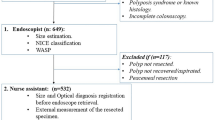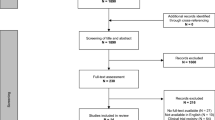Abstract
Background and aims
The aim of this study was to determine the detection rate of polyps using zoom chromoendoscopy (ZE) compared with standard video colonoscopy.
Patients and methods
End-to-end colonoscopies were performed in 50 patients by two different endoscopists blinded for each other’s results. Lesions detected during initial standard colonoscopy (C1) were biopsied or removed by snare resection. The second colonoscopy (C2) was done with a zoom colonoscope spraying the whole colon with indigocarmine (0.4%). In addition, detected mucosal lesions were documented prior to ZE and then classified according to the pit pattern classification before biopsy or removal. The retrieval time for each procedure was determined. Results: The average retrieval time for C1 was 13±9 min (9–24) and 28±11 min (16–38, p<0.05) for ZE. During C1, 56 lesions were detected in 26 of 50 patients (34 hyperplastic and 22 adenomatous). During C2, 19 additional polyps were documented prior to ZE (15% tandem miss rate), and 20 further lesions were detected with ZE (21% additional polyp detection rate compared to C1 and C2 without ZE). Of the 39 additional lesions removed during C2 after ZE, 29 were hyperplastic and 10 were adenomatous. Most adenomas detected during the second investigation were found in patients in whom adenomatous polyps had already been removed during the initial colonoscopy (9 of 26 patients vs 1 of 24 patients, p<0.02). No carcinoma was detected. The pit pattern classification allowed a correct differentiation between hyperplastic and adenomatous polyps (accuracy 93%, sensitivity 90%, specificity 97%).
Conclusion
Using zoom chromoendoscopy, the rate of detecting colonic polyps can be increased at the cost of a longer retrieval time.

Similar content being viewed by others
References
Kudo S, Hirota S, Nakajima T et al (1994) Colorectal tumours and pit pattern. J Clin Pathol 47:880–885
Kudo S, Tamura S, Nakajima T et al (1996) Diagnosis of colorectal tumorous lesions by magnifying endoscopy. Gastrointest Endosc 44:8–14
Kudo S, Rubio CA, Teixeira CR et al (2001) Pit pattern in colorectal neoplasia: endoscopic magnifying view. Endoscopy 33:367–373
Kudo S, Kashida H, Nakajima T et al (1997) Endoscopic diagnosis and treatment of early colorectal cancer. World J Surg 21:694–701
Axelrad AM, Fleischer DE, Geller AJ et al (1996) High-resolution chromoendoscopy for the diagnosis of diminutive colon polyps: implications for colon cancer screening. Gastroenterology 110:1253–1258
Fujii T, Rembacken BJ, Dixon MF et al (1998) Flat adenomas in the United Kingdom: are treatable cancers being missed? Endoscopy 30:437–443
Kato S, Fujii T, Koba I et al (2001) Assessment of colorectal lesions using magnifying colonoscopy and mucosal dye spraying: can significant lesions be distinguished? Endoscopy 33:306–310
Kiesslich R, von Bergh M, Hahn M et al (2001) Chromoendoscopy with indigocarmine improves the detection of adenomatous and non-adenomatous lesions in the colon. Endoscopy 33:1001–1006
Winawer SJ, Zauber AG, Ho MN et al (1993) Prevention of colorectal cancer by colonoscopic polypectomy. N Engl J Med 329:1977–1981
Fruehmorgen P (1997) Kolorektale Polypen. In: Sauerbruch T, Scheuerlen C (eds) Leitlinien der Deutschen Gesellschaft für Verdauungs- und Stoffwechselkrankheiten. Demeter-Verlag, Balingen, pp 86–92
Newcomb PA, Norfleet RG, Storer BE et al (1992) Screening sigmoidoscopy and colorectal cancer mortality. J Natl Cancer Inst 84:1572–1575
Atkin WS, Morson BC, Cuzick J (1992) Long-term risk of colorectal cancer after excision of rectosigmoid adenomas. N Engl J Med 326:658–662
Selby JV, Friedman GD, Quesenberry CP et al (1992) A case-control study of screening sigmoidoscopy and mortality from colorectal cancer. N Engl J Med 326:653–657
Hofstad B, Vatn M, Norheim Andersen S, Hitfeldt HS, Rognum T, Larsen S et al (1996) Growth of colorectal polyps: redetection and evaluation of unresected polyps for a period of three years. Gut 39:449–456
Winawer SJ (1999) Appropirate intervals for surveillance. Gastrointest Endosc 49:S63–S66
Byrne MF (2000) The curse of poor bowel preparation for colonoscopy. Am J Gastroenterol 97:1587–1589
Rex DK, Imperiale TF, Latinovic DR et al (2000) Impact of bowel preparation on efficiency and cost of colonoscopy. Am J Gastroenterol 97:1696–1700
Rex DK, Cutler CS, Lemmel GT et al (1997) Colonic miss rates of adenomas determined by back-to-back colonoscopies. Gastroenterology 112:24–28
Brooker JC, Saunders BP, Shah SG et al (2002) Colonoscopy: total colonic dye-spray and detection of diminutive adenomas. Gastrointest Endosc 56:333–338
Chapuis PH, Dent OF, Goulston KJ (1982) Clinical accuracy in the diagnosis of small polyps using the flexible fiberoptic sigmoidoscope. Dis Colon Rectum 25:669–972
Neale AV, Demers RY, Bude H et al (1987) Physician accuracy in diagnosing colorectal polyps. Dis Colon Rectum 29:247–250
Tung SY, Wu CS, Su MY (2001) Magnifying colonoscopy in differentiating neoplastic from non-neoplastic colorectal lesions. Am J Gastroenterol 96:2628–2632
Eisen GM, Kim CY, Fleischer DE et al (2002) High-resolution chromoendoscopy for classifying colonic polyps: a multicenter study. Gastrointest Endosc 55:687–694
Fujii T, Hasegawa T, Saitoh Y et al (2001) Chromoscopy during colonoscopy. Endoscopy 33:1036–1041
Rutter M, Bernstein C, Mastumoto T, Kiesslich R, Neurath M (2004) Endoscopic appearance of dysplasia in ulcerative colitis and the role of staining. Endoscopy 36(12):1109–1114
Author information
Authors and Affiliations
Corresponding author
Rights and permissions
About this article
Cite this article
Stergiou, N., Frenz, M.B., Menke, D. et al. Reduction of miss rates of colonic adenomas by zoom chromoendoscopy. Int J Colorectal Dis 21, 560–565 (2006). https://doi.org/10.1007/s00384-005-0052-y
Accepted:
Published:
Issue Date:
DOI: https://doi.org/10.1007/s00384-005-0052-y




